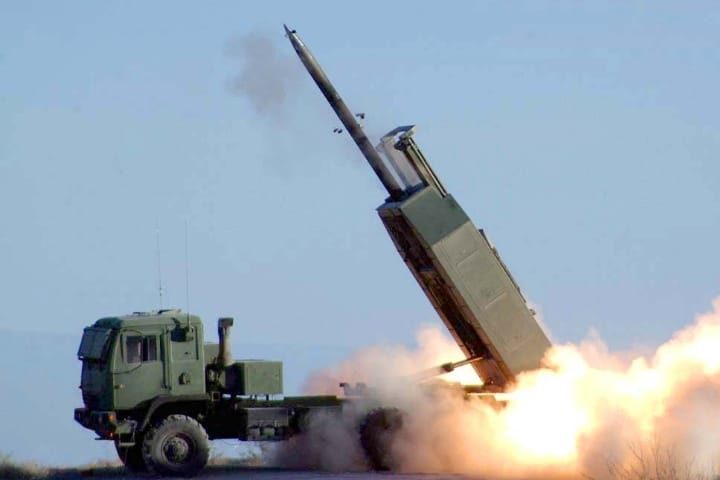
The Wall Street Journal (WSJ) reported on Tuesday that American arms manufacturers are struggling to procure ample rocket motors to produce missiles for Ukrainian forces, with production targets postponed as various contractors have been depending on one supplier.
In its quarterly earnings report unveiled on Tuesday, Lockheed Martin claimed that while its overall sales increased from a year earlier, sales of Guided Multiple Launch Rocket Systems (GMLRS) dropped because of a “lower volume” of output.
GMLRS projectiles are artillery rockets fired from Lockheed Martin’s M142 HIMARS platform. Based on recent Pentagon figures, the United States has supplied Ukraine with 38 HIMARS platforms, and while the Defense Department failed to reveal how many GMLRS projectiles they have deployed to Kyiv, a November 2022 Reuters report asserted that the figure exceeded 5,000, more than the 4,600 Lockheed Martin can make annually.
Hence, the company has been hindered in enhancing production due to a paucity of rocket motors, the WSJ report stated, adding that other missile makers such as Raytheon Technologies have also felt similar impacts.
Moreover, Lockheed Martin uses solid-fuel rocket motors in its Javelin anti-tank missiles, more than 8,500 of which have been transported to Ukraine over the last year. When President Joe Biden went to the company’s Javelin manufacturing facility in Alabama last May, CEO Jim Taiclet pledged to double production of the shoulder-fired missiles by 2024. Nevertheless, the Pentagon and the company have since told WSJ reporters that the scheduled date has been postponed to 2026.
“We thought we could get there earlier,” Lockheed Martin’s Chief Financial Officer, Jay Malave admitted.
U.S. missile production companies such as Lockheed Martin and Raytheon Technologies obtain their rocket motors from just one supplier, Aerojet Rocketdyne Holdings. That being said, while the Pentagon awarded Aerojet a $216 million contract to bolster production, the supplier claimed that it was still reeling from the aftermath of a fire at one of its factories in 2022.
Although there is a seeming postponement of rocket artillery and guided-missile production, Ukraine is allegedly struggling with a lack of conventional artillery rounds, according to recent leaked Pentagon documents. The documents also disclosed that such a shortfall is hindering a planned spring offensive by Ukrainian forces, with America turning to its allies to replenish Ukraine’s stockpiles.
Likewise on April 21, the New York Times (NYT) reported that the United States and its allies have not deployed the tanks, artillery ammunition, and other supplies required by Ukraine to launch a spring offensive against Russia, quoting the aforementioned leaked Pentagon documents.
U.S. military planners estimated that Kyiv would require 253 tanks for the planned attack, but only managed to obtain 200 by late February. Of those obtained, 140 were Soviet designs while only 60 tanks of Western manufacture would be delivered by this month, the Times reported.
The West is facing challenges in fulfilling its pledge to provide Ukraine with tanks, air defense systems, fighter jets, and other weapons, the newspaper remarked. Three Ukrainian brigades readying for the planned offensive against Russia were lacking “at least a dozen tanks each” as of February 28.
Washington has purportedly sped up the delivery of the 31 promised M1 Abrams main battle tanks to Ukraine, but these tanks would reportedly not be ready before an unspecified time later this year. Although a dozen or so British Challenger 2 tanks have arrived in Ukraine, most of the German-made Leopard tanks are still undergoing an overhaul.
As of March 1 this year, Kyiv’s stockpile of 155-mm artillery shells dropped to 9,800, with America delivering another 30,000 over the next 12 days. The NYT article pointed out that the Ukrainian desire for artillery ammunition is currently “essentially limitless” while the EU and U..S industry would “take years to catch up with the demand.”
According to the same report, the United States has only “offered” to supply Ukraine with Ground Launched Small Diameter Bombs (GLSDB), which have a range of around 140 kilometers, highlighting that “they must first be built, and production of even a small batch could take months.” In the meantime, reports have alleged that Ukraine has already used the GLSDB, the latter subsequently intercepted by Russian air defenses.
In March this year, Czech President Petr Pavel admitted his country’s limitations in producing more arms for Ukraine to fend off Russia, owing to workforce shortages.
“We have not only delivered what we could from our own stocks, but also bought material abroad,” Pavel said in an interview with Germany’s Suddeutsche Zeitung.
The Czech Republic is still capable of producing some air defenses and ammunition that Ukraine requires, but it’s “limited by the shortage of workforce,” he added.
“We have one of the lowest unemployment rates in Europe. Workers are hard to come by. But there are opportunities, for example, through [bringing in] workers from Ukraine,” continued Pavel, who was inaugurated as president on March 9 and who has an intelligence background and was the chairman of the NATO Military Committee between 2015 and 2018.
Pavel then hinted that 2023 would be “decisive” for the outcome of the Ukraine conflict, also cautioning that Western support for Ukraine “will diminish over time” as a result of “war fatigue.”
With the upcoming presidential election in the United States in 2024, American voters could turn from foreign to domestic matters, he stated.
“It is virtually impossible for the Europeans alone to maintain the current level of support for Ukraine. If US support weakens, so does the support of a number of European states,” the 61-year-old remarked.
Ukraine has to take these factors into consideration when it plans its strategy as “next year, it’ll probably be unable to start any large and elaborate operation,” Pavel said.
The Czech Defense Ministry asserted that the country had supplied Kyiv with €2.3 billion ($2.5 billion) worth of arms during the conflict at the point of Pavel’s interview. Citing security and tactical concerns, Prague did not provide further details on the types of weapons supplied.
Importantly, the Pentagon has never officially authenticated the leaked Pentagon documents that emerged on social media earlier this month. At a White House briefing on April 10, National Security Council spokesman John Kirby said that the documents were “not intended for public consumption” and had “no business” being “on the front pages of newspapers or on television.”
The days that followed witnessed the NYT and Washington Post working with the Netherlands-based leftist group Bellingcat founded by Eliot Higgins, previously accused of working for the CIA, to locate the source of the leak. Eventually, the NYT identified Jack Teixeira, a Massachusetts Air National Guard airman, as the source. After Teixeira’s arrest, various news publications began reporting on the contents of the leaked documents.
On its end, Russia has slammed arms deliveries to Ukraine from the West several times, maintaining that such actions would only drag the conflict on without influencing the eventual outcome. Moscow asserted that Western arms shipments, intelligence sharing, and training offered to Kyiv’s troops have already made Western nations de facto participants in the conflict.
The West’s involvement “is rising gradually,” Kremlin spokesman Dmitry Peskov said.

